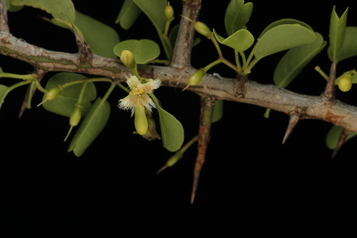biaachi Name given to the <Ximenia americana> of the Olacaceae family. [...]
| Part of Speech | s |
| PDLMA | b.yaa*chi* |
| Speaker | {EJG,FSL14,RLC14,FSL15,RLC15,VOT15} |
-
- Name given to the <Ximenia americana> of the Olacaceae family. This is a thorny tree that reaches a height of 4 meters. The edible fruit, which ripens in the dry season, is yellow, bitter, and very small, and in the past was regularly eaten instead of commercial plums. It is also eaten by iguanas. The tree has a light yellow flower that smells like jasmine. It should not be confused with the tree known as <biadxi dani> or <biadxi gui'xhi'> that is also called <biaachi> by some people. In his <Guía Gráfico-Fonémica para la Escritura y Lectura del Zapoteco>, Eustaquio Jiménez Girón associated this name with the tree of the Anacardiaceae family known in Spanish as <jobo>. This suggests that the name <biaachi> might correspond to more than one species of tree.
- Nombre que se le da a <Ximenia americana>, perteneciente a la familia Olacaceae. Árbol espinoso que alcanza una altura de 4 metros. La flor es pequeña de color amarillo claro y huele a jazmín. Su fruta es amarilla y muy chiquita, ácida y comestible. Anteriormente, la gente la consumía regularmente en vez de la ciruela comercial. La iguana se alimenta de la fruta, que madura en tiempo de sequía. Es importante no confundir <biaachi> con el ciruelo del cerro que se llama <biadxi dani> o <biadxi gui'xhi'> pues algunas personas también lo llaman <biaachi>. Eustaquio Jiménez Girón en su <Guía Gráfico-Fonémica para la Escritura y Lectura del Zapoteco> asocia el nombre <biaachi> con el árbol conocido como el <jobo> y que él reporta que pertenece a la familia Anacardiaceae. Esto sugiere que podría haber más de una especie que se conoce o se conoció con el mismo nombre <biaachi>. [Spanish]
- Yagadi' risooni bia' tapa metru. Laani zeda gacagani casi ti yaga biadxi rindani lu gui'xhi', rudiini ti cuananaxhi nabiuxe, naguchi lu, nabe naí'. Cadi nguecani ne biadxi gui'xhi' o biadxi dani, ma' gadxeni. Rului'ni biadxi lu guidxi ne rinda' naxhini. Dxique ca binni rañaa nabe gudoni, yanna ma guchachi'si roni. Ca cuananaxhidi' ricáca' lu gusiba. Yagadi' napani bandaga nayu'la natuxhu, ruzaani ladi ne napani guichi naro'ba. [Diidxazá]
-
-
Example 10:
biaachi la? ti yaga huiinini napani stale guiichi la? ni rábido biaachi ca la? purti nuu binni runi ruchee la? zandaca ora rabicabe sti yaga biaachi ni nuu dàni ca naa ni riene biaachi la? ni napa yaga stale guiichi ca la? ne ricá ti guie' naquichi naguchi, naduubi huiini' luni nabiixe ne cuananaxhi stìni la? ora nayaa la? verde laa, pero ora ma nagüini ca la? ma güini la? naguchi ne nabé ró guchachini la? ne laaca zanda gó binnini también pero nabé naí' nahínì ne stobi ni nuu dàni ca la? ngá casi yaga biádxi laa, peru nuu ca binni góla ca la? laaca rábicabeni biaachi, ni nuu dàni ca, peru ngá laaca casi yaga biadxi ngaca naguchi cuaananaxhi ca la? peru yaga ca la? cadi qui gápadini guiichi, casi yaga biádxini ngá puru dàni ridxélani, ndi nuu ndi ndaani dàni también la? ne nuuni lu ca guiixhi layú xaguete', nabé ró guchachinibiaachi is a small tree with many thorns that's what we call biaachi because some people confuse the biaachi with a tree that is found up in the hills what I know about biaachi is that it is a tree with many thorns which produces flower that are white and yellow, and its fruit is green early on and when it ripens, when it ripens it is yellow the iguanas eat it and people can also eat it but it is said that it is very sour the other tree up in the hills is similar to the cherry tree, but some of the elders say that the tree up on the hills is also called biaachi, but it alsmost like a cherry tree the fruit is yellow but the tree is not thorny, its almost like a cherry tree, but it is only found up on the hills, biaachi is also found in the hills but also in the lower elevations and the iguanas eat its fruitsel ciruelillo es una plantita, tiene muchas espinas a lo que llamamos ciruelillo, porque hay personas que se confunden, puede que le llamen ciruelillo a otro árbol que está en el cerro lo que conozco como ciruelillo es el árbol que tiene mucha espina y da flores blancas con amarillas, suavecita y pequeñita y su fruto, cuando está tierno, es verde, pero cuando ya está maduro es amarillo y lo comen mucho las iguanas, también lo pueden comer las personas pero es muy agrio y el otro que está en el cerro es como el árbol de ciruela, pero hay ancianos que también le llaman ciruelillo, el que está en el cerro, pero ese también es como la ciruela la fruta es amarilla pero el árbol no tiene espinas, es como el árbol de ciruela, pero ese se cuentran sólo en los cerros, este se encuentra también en el cerro y se cuentra en los montes de la parte baja, lo comen mucho los iguanas [Spanish]
-
Taxa <Ximenia americana>





